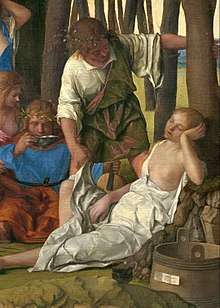Lotis (mythology)
Lotis was a nymph mentioned by Ovid.[1] In his account, at the Liberalia festival, Priapus tried to rape her when everyone had fallen asleep, but she was awakened by a sudden cry of Silenus's donkey and ran off, leaving Priapus in embarrassment as everyone else woke up too and became aware of his intentions.[2] In another account, she was changed into a lotus tree to escape Priapus; later, Dryope picked a flower off the tree Lotis had become, and was transformed into a black poplar.[3]


In Book 6 of the Fasti Ovid tells much the same story, but with the goddess Vesta rather than Lotis as the intended victim. According to some sources, Lotis was the daughter of Neptune or Nereus. Ovid suggests that Priapus later kills the donkey.
In art
The story does not seem to feature in Ancient Greek vase-painting, and only occasionally in later art. Priapus and Lotis appear in the right foreground of The Feast of the Gods by Giovanni Bellini (c. 1514),[4] in an engraving by Giovanni Battista Palumba (c. 1510), and a drawing by Parmigianino of the 1530s. Bellini keeps Priapus's aroused state visible under his clothes,[5] Palumba has it out in the open, as Parmigianino originally did, but this has been altered subsequently,[6] as very explicit details often were in art. There are also some depictions of Lotis as a tree.[7]
Notes
- Theoi Project - Lotis gives the two passages
- Ovid, Fasti, 1. 391 ff
- Ovid, Metamorphoses, 9. 347 ff
- Bull, 242
- Hall, 253
- Bayer, 196; British Museum collection database
- Bayer, 196
References
- Bayer, Andrea, Art and Love in Renaissance Italy, 2008, Metropolitan Museum of Art, ISBN 1588393003, 9781588393005, google books
- Bull, Malcolm, The Mirror of the Gods, How Renaissance Artists Rediscovered the Pagan Gods, Oxford UP, 2005, ISBN 0195219236
- Hall, James, Hall's Dictionary of Subjects and Symbols in Art, 1996 (2nd edn.), John Murray, ISBN 0719541476